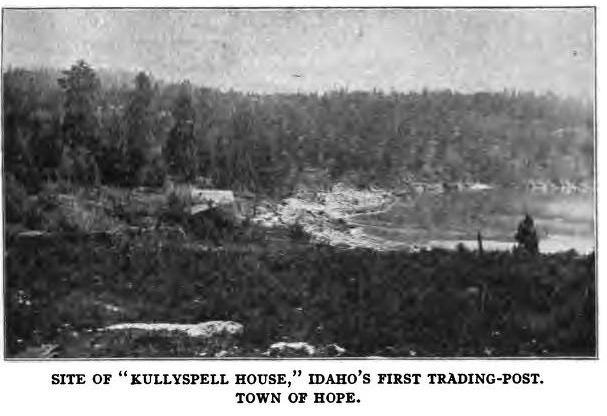Northwest Company, Kullyspell Trading Post - Idaho's first trading-post
Abstracted from "History of the State of Idaho," by Cornelis J. Brosnan, published by Charles Scribner's Sons, 1918.
43. The Coming of the Trappers. For a half-century after the Lewis and Clark expedition the onward movement of events in Idaho is the story of the operations of fur companies. While there were numerous fur-trading organizations in the field, the most powerful of them all was the Hudson's Bay Company, whose Columbian headquarters were at Fort Vancouver in the present State of Washington.
44. The Northwest Company. To a representative of the Northwest Company, whose headquarters were at Fort William on Lake Superior, belongs the distinction of having built Idaho's first trading-post. On September 10, 1809, David Thompson, a partner, having entered Idaho from the north began to erect substantial log houses near the site of the present town of Hope on the northeast shore of Lake Pend d'Oreille under the name of "Kullyspell House." This trading-post was in actual use for two winters, when it was abandoned for a more favorable location near the present city of Spokane. While David Thompson was an Englishman, Americans as well as his own countrymen can well afford to honor his memory, for he was an intrepid pathfinder, an accurate surveyor and geographer, and an upright man.

45. Later Activities of the Northwest Company in Idaho. The Northwest Company continued to trade with our Idaho Indians until 1821, when it was merged into the greater Hudson's Bay Company. The "Northwesters," as they are often called, pushed the fur-trading business in Idaho with vigor during the years 1818, 1819, 1820, and 1821. With Fort Nez Perce (Fort Walla Walla) as a base, they trapped along our rivers and streams and carried away a golden harvest of peltries. The manager and chief factor during these romantic years was Donald Mackenzie, an experienced "bourgeois,"I of powerful frame, fearless as a lion, and a master of Indian wiles and strategy. It is to Donald Mackenzie that we are indebted for the naming of the Weiser, Payette, Boise, Malade, the Portneuf, as well as other well-known Idaho rivers.
Brosnan continues the Kullyspell story in the 1935 edition:
Kullyspell House, the first building erected by white men in Idaho, was destroyed by a forest fire about 1935, but its two stone chimneys remained stranding probably twenty years longer. Not until 1923 was the exact site of this historic trading post found, and then only through the clear memory of a blind, eighty-year-old Indian, Klai-Too, who had seen the gaunt chimneys when he was a small boy. Led to a "bear paw" rock opposite Memaloose Island, he described through an interpreter, the spot where the chimneys had stood. There two piles of even-sized rocks were discovered, overgrown with brush and vines. In one of them searchers uncovered a regular cavitity resembling a fireplace, and in it traces of ashes. The citizens of Bonner County erected a monument over the site in 1929, commenorating not only the first house ever erected in the state of Idaho, but its builder, David Thompson.
. . .At Kullyspell House, on September 13, 1809, David Thompson exchanged in barter '120 or 130 skins' with the Indians of his vicinity. This was the first commercial transaction which ever took place in the present State of Idaho. From here, also in the spring of 1810, took place the first shipment by freight of goods from Idaho, which was accomplished by the use of 16 pack-horses. In his first commercial contribution to the outside world, David Thompson pressed and packed for shipment across western Canada to Fort William on Lake Superior, 46 packs of furs, each weighing 90 pounds. Later, true to his religious teaching and training, David Thompson made the first record of the observance of Easter in Idaho. The entry in his journal at Kullyspell House on Sunday April 22, 1810, read: 'A fine Easter Sunday, rested all day.'

Webspace for this site is generously provided by Genealogy Village and Access Genealogy
Copyright © 2013 - Sharon McConnel. All Rights Reserved.
